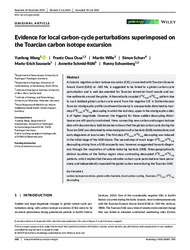Evidence for local carbon‐cycle perturbations superimposed on the Toarcian carbon isotope excursion
Ossa Ossa, Frantz
Wille, Martin
Schurr, Simon
Saussele, Mario‐Erich
Schmid‐Röhl, Annette
DOI: https://doi.org/10.1111/gbi.12410
Persistent URL: http://resolver.sub.uni-goettingen.de/purl?gldocs-11858/8490
Persistent URL: http://resolver.sub.uni-goettingen.de/purl?gldocs-11858/8490
Wang, Yunfeng; Ossa Ossa, Frantz; Wille, Martin; Schurr, Simon; Saussele, Mario‐Erich; Schmid‐Röhl, Annette; Schoenberg, Ronny, 2020: Evidence for local carbon‐cycle perturbations superimposed on the Toarcian carbon isotope excursion. In: Geobiology, Band 18, 6: 682 - 709, DOI: 10.1111/gbi.12410.
 |
Dokument öffnen: |
A Jurassic negative carbon isotope excursion (CIE), co‐evolved with Toarcian Oceanic Anoxic Event (OAE) at ~183 Ma, is suggested to be linked to a global carbon‐cycle perturbation and is well documented for Toarcian terrestrial fossil woods and marine sediments around the globe. A theoretically coupled δ13Ccarb‐δ13Corg pattern due to such dubbed global carbon‐cycle event from the negative CIE in Dotternhausen Toarcian stratigraphic profile (southwest Germany) is unexpectedly disturbed by two‐step δ13Ccarb‐δ13Corg decoupling in which the last step, upper in the stratigraphic order, is of higher magnitude. However, the trigger(s) for these sudden decoupling disturbances are still poorly constrained. Here, connecting new carbon and oxygen isotope data with documentary lipid biomarkers shows that the global carbon cycle during the Toarcian OAE was disturbed by enhanced green sulfur bacteria (GSB) metabolisms and early diagenesis at local scales. The first step δ13Ccarb‐δ13Corg decoupling was induced in the initial stage of the GSB bloom. The second step of much larger δ13Ccarb‐δ13Corg decoupling arising from a GSB prosperity was, however, exaggerated by early diagenesis through the respiration of sulfate‐reducing bacteria (SRB). Paleo‐geographically distinct localities of the Tethys region show contrasting decoupled δ13Ccarb‐δ13Corg patterns, which implies that the second‐order carbon‐cycle perturbations have pervasively and independently impacted the global carbon event during the Toarcian OAE.
Statistik:
ZugriffsstatistikSammlung:
Schlagworte:
carbon isotope excursiongreen sulfur bacteria
local carbon cycling
Toarcian
δ13Ccarb‐δ13Corg decoupling
This is an open access article under the terms of the Creative Commons Attribution License, which permits use, distribution and reproduction in any medium, provided the original work is properly cited.

